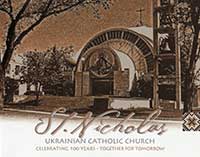by Alexandra Pawlowsky
University of Manitoba
|
Athanasius McVay and June Dutka, editors, St. Nicholas Ukrainian Catholic Church: Celebrating 100 Years—Together for Tomorrow Winnipeg: St. Nicholas Ukrainian Catholic Church, 2006, 348 pages, ISBN 0973971312, $50.00 (paperback)
 “I am your church Make me worthy of your support and concern Come, worship with me, and support me, and I will serve you all your days.”
“I am your church Make me worthy of your support and concern Come, worship with me, and support me, and I will serve you all your days.”
From the inaugural blessing of St. Nicholas Ukrainian Catholic Church erected on its third site in Winnipeg in 1966, the symbiotic union between St. Nicholas Ukrainian Catholic Church in Winnipeg and its community has flourished for over a century.
The commemorative book, St. Nicholas Ukrainian Catholic Church: Celebrating 100 Years—Together for Tomorrow outlines the church’s history through its first century. It does so with text, photos and reproductions of rare archival documents. The exact date of when the church was established is sometimes said to be 1899, the time when the early Ukrainian settlers in Winnipeg gathered as a faith community and when they had no permanent place of worship. Other times it is said to be 1901, when Father Polywka, Order of St. Basil the Great, arrived in Winnipeg and helped the faithful purchase the plot of land where the first church was built and officially consecrated. This Byzantine rite church continues to be administered by the Order of St. Basil the Great. This book, the definitive source for information relating to St. Nicholas Church, sets the parameters of 100 years at 1901–2001.
Father Athanasius McVay, OSBM, served as the book’s editor-in-chief, while June Dutka, Librarian Emerita at the University of Manitoba, carried out the research and writing of the English text and identified the majority of the photos. Cynthia Chuckree was responsible for the graphic design.
Visually the book resembles a coffee table volume. Its glossy cover and overall design is pleasing to the eye. Even its oversize format lends itself more to the coffee table than to the reference desk. However deceptive its format, the book in its entirety, is a useful reference tool.
St. Nicholas Ukrainian Catholic Church is unique in that it was not only the first Ukrainian Catholic church established in Winnipeg, but it was also the first established in all of urban Canada. Why Winnipeg? As the gateway to the west, Winnipeg was the hub for all Ukrainian activity in Canada. The city’s North End was where the Ukrainians settled and lived their lives. And, it was in the North End, on the corner of Stella Avenue and McGregor Street, that the first St. Nicholas Church was erected in 1901.
Most of the book is in English, but the chapters devoted to church history are bilingual, both English and Ukrainian text. Although both texts deal with the history of how the church came into existence, the politics involved in establishing a Byzantine rite church in a country where up to that time this rite was foreign, and the building of the three church structures which housed the parish over the century, the two texts are not exact translations of each other.
Besides the history of the church itself, the work traces the history of the Order of St. Basil the Great and the Sister Servants of Mary Immaculate in Canada. The history of the two religious orders is intertwined; they arrived in Canada together in the early 1900s and have worked together offering mutual support to each other ever since. For example, whereas, the Basilian Fathers established St. Nicholas Church the Sister Servants established the first Ukrainian Catholic day school, St. Nicholas School (since renamed Immaculate Heart of Mary School), in Winnipeg, and thus, in Canada. In addition, the book examines the history of the school, its influence on students and activities.
The many and varied activities sponsored by and associated with St. Nicholas Church have always extended beyond the realms of liturgies and classrooms. June Dutka’s research and documentation does justice to all church related groups, clubs and organizations: the Knights of Columbus, the Ukrainian Catholic Women’s League, Altar servers, Children of Mary, choir, youth and seniors’ clubs, sports clubs and many more.
The layout of the book is fairly standard for a Ukrainian Catholic church publication. It begins with letters of greeting, in this case, on the occasion of the church’s centenary, from all levels of clergy, starting with the secretariat of the Vatican and ending with the parish priest, Father McVay—albeit Father McVay’s letter reads more like a prologue to the book than a greeting. The book concludes with a list of donors who made financial contributions to cover publication costs.
Ostensibly a church history, the book’s significance extends far beyond that of the church organization. It is a cultural and social history as well, not only of the church and its faith community, but the broader community overall. It is modest on this topic, perhaps even too modest, for every long time North End resident knows that its clubs and activities reached out to many, particularly the youth, Catholic and non-Catholic, Ukrainian and non-Ukrainian. In this way, St. Nicholas Church has always been a positive presence and a uniting force within the community.
It becomes clear that the book is a tribute to St. Nicholas Ukrainian Catholic Church, its pioneers and present day parishioners. The church became more than just a physical structure. Rebuilt three times in the course of 100 years of uninterrupted history, the church itself, as indeed the book, is a triumph of spirit and energy celebrating the faith, clergy and people of its community who have a great many potential successes still ahead of them.
St. Nicholas Ukrainian Catholic Church, April 2005.
Source: Gordon Goldsborough
Page revised: 8 February 2015